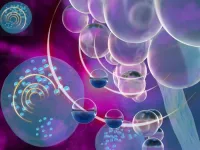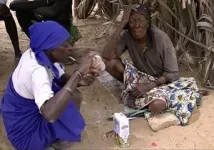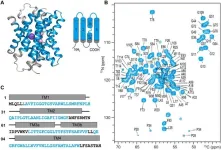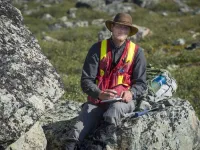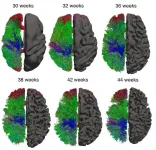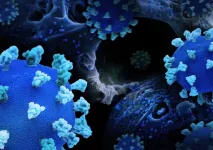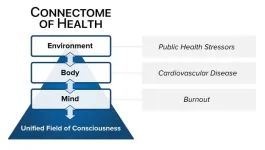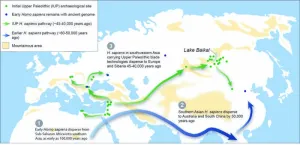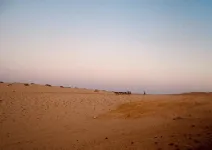(Press-News.org) UNIVERSITY PARK, Pa. — Macrophages are little cells vital to the immune system and could possibly inform cell-based therapies for a variety of medical conditions. However, realizing the full potential of macrophage therapies relies on being able to see what these cellular allies are doing inside our bodies, and a team of Penn State researchers may have developed a way to watch them do their thing.
In a study published in the journal Small, the Penn State researchers report a novel ultrasound imaging technique to view macrophages continuously in mammal tissue, with potential for human application in the future.
"A macrophage is a type of immune cell that is important in nearly every function of the immune system, from detecting and clearing pathogens to wound healing,” said corresponding author Scott Medina, the William and Wendy Korb Early Career Associate Professor of Biomedical Engineering. “It is a component of the immune system that really bridges the two types of immunity: innate immunity, which responds to things very quickly but in a not very precise way, and adaptive immunity, which is much slower to come online but responds in a much more precise way.”
Macrophages regulate these two arms of the human immune response and help our body with functions such as fighting infections and tissue regeneration. On the flip side, they also help mediate inflammation related to injuries and diseases such as diabetes and rheumatoid arthritis. According to Medina, these cells could be harnessed and applied in therapies that would help patients with conditions such as cancer, autoimmune disorders, infections and damaged tissue. Such therapies would involve isolating, modifying, and/or engineering macrophages to enhance their properties to combat disease, control immune responses and promote tissue repair.
"If we could visualize what these cells are doing in the body, in real-time, then we could learn a lot about just how diseases progress and how healing happens," Medina said. “This would give us a view of what the cells are doing in the body because right now, we're really limited to taking the cells out of the body and seeing what they do in a petri dish, which is not going to be the same behavior that we see in the body."
The researchers turned to ultrasound imaging, a common technique to see the body’s internal tissues. However, with ultrasound alone, macrophages blend in with their fellow cells.
"Macrophages are basically invisible during ultrasound imaging because you can't distinguish where the cells are relative to all the other cells that are in our tissue,” Medina said. “They all behave the same so you cannot really see specific cells. We had to create what is called a contrast agent, something that our cells of interest could be labeled with that would then provide some image contrast that would be different from the background. And that is where these nanoemulsions came in.”
Many home cooks know emulsions as a mixture of oil droplets suspended in a liquid such as vinegar or water to make salad dressing; a nanoemulsion is when those oil droplets are tiny, mere nanometers in diameter.
The researchers used nanoemulsions to create more resilient bubbles. Gas bubbles reflect an ultrasound’s soundwaves very efficiently; however, if someone injects bubbles into a patient’s body, they do not work very well because they burst relatively quickly.
“We needed a way to basically get bubbles to form when we want them to form right at the time of imaging and not before, and also for these bubbles to persist as long as possible,” said Inhye Kim, post-doctoral fellow in biomedical engineering and lead author of the study.
The researchers introduced nanoemulsion droplets to the cells, which internalized them. Under ultrasound, the droplets then went through a phase change, turning into a gas and, therefore, a bubble. The pressure from the ultrasound waves facilitated this change, pushing and pulling on the droplet as the wave oscillates and uses pressure to force the droplet to boil, making it vaporize and turn into a gas bubble.
“It is similar to how water will boil at a lower temperature at a higher elevation, in say Colorado, because there is less pressure preventing it from boiling,” Medina said. “We are using the pressure that we're applying on that droplet through ultrasound to effectively get it to boil when we want it to boil so then it vaporizes and causes the formation of this gas bubble.”
They tested this novel technique in a porcine tissue sample and found that the imaging of the macrophages worked. The approach allows researchers to see what immune cells are doing in the body in a continuous fashion, enabling a better understanding of how the immune system is regulated and what its role is in fighting diseases, Medina said. Beyond that, Kim noted, it can also help with developing better immune cell therapies for patients in the future.
"For example, for a patient with a tumor, this research could enable the engineering of a macrophage cell therapy that is more effective and has fewer and less serious side effects,” Kim said.
Next steps in the research include exploring the possibility of using this technique for other types of immune cell visualization within the human body, or to monitor buildup of plaque within arteries. In addition, the researchers are seeking collaborators to advance the technique.
“We are hoping to work with others in immunology research that have particular interests and might find this technology useful, so we are definitely open to further collaborations and applications,” Medina said.
Along with Medina and Kim, other researchers include Jacob Elliot, graduate student in acoustics; Atip Lawanprasert, research assistant in biomedical engineering; Grace Wood, doctoral student in acoustics; and Juliana Simon, assistant professor of acoustics. The National Science Foundation Early Career Award and the National Institutes of Health supported this research.
END
Tiny bubbles could reveal immune cell secrets and improve treatments
Penn State researchers develop novel bubble-based technique to watch immune cells at work
2023-09-22
ELSE PRESS RELEASES FROM THIS DATE:
Solid-state NMR unveils fluoride ion channel permeation mechanism
2023-09-22
On August 23, 2023, a research team led by SHI Chaowei from the University of Science and Technology of China (USTC) of the Chinese Academy of Sciences (CAS) published a paper titled "Fluoride permeation mechanism of the Fluc channel in liposomes revealed by solid-state NMR" in Science Advances. The team adopted the fluoride ion channel protein Fluc-Ec1 combined with deuterium substitution and 19F labeling methods, paving a new path for membrane protein nuclear magnetic resonance (NMR) research.
NMR not only provides insights into molecular structures ...
Earth’s crust, tectonic plates gradually formed, geoscientists find
2023-09-22
UNIVERSITY PARK, Pa. — The Earth’s crust continued a slow process of reworking for billions of years, rather than rapidly slowing its growth some 3 billion years ago, according to a Penn State-led research team. The new finding contradicts existing theories that suggest the rapid formation of tectonic plates earlier in Earth’s history, researchers said.
They published the research in Geochemical Perspectives Letters.
The work may help answer a fundamental question about our planet and could hold clues as to the formation of other planets, according to lead author ...
Dinosaur feathers contain traces of ancient proteins, study finds
2023-09-22
How similar are dinosaurs to modern birds? This question is at the heart of a new study that examined how proteins found in dinosaur feathers changed over millions of years and under extreme heat.
Previous studies suggest that dinosaur feathers contained proteins that made them less stiff than modern bird feathers. Now, researchers with University College Cork (UCC), the Stanford Synchrotron Radiation Light Source (SSRL) at the Department of Energy's SLAC National Accelerator Laboratory and other institutions have discovered that dinosaur feathers originally had a very similar protein composition to those of modern birds. That result ...
Q&A: How new software is changing our understanding of human brain development
2023-09-22
A single brain is unfathomably complex. So brain researchers, whether they’re looking at datasets built from 300,000 neurons in 81 mice or from MRIs of 1,200 young adults, are now dealing with so much information that they must also come up with new methods to comprehend it. Developing new analysis tools has become as important as using them to understand brain health and development.
A team including researchers at the University of Washington recently used new software to compare MRIs from 300 babies and discovered that myelin, a part of the brain’s so-called white matter, develops much slower after birth. The researchers published their findings Aug. ...
Clinical trial to test immune modulation strategy for hospitalized COVID-19 patients begins
2023-09-22
A clinical trial has launched to test whether early intensive immune modulation for hospitalized COVID-19 patients with relatively mild illness is beneficial. The placebo-controlled study, part of the global clinical trials consortium known as Strategies and Treatments for Respiratory Infections and Viral Emergencies (STRIVE), will enroll approximately 1,500 people at research sites around the world. It is supported by the National Institutes of Health’s National Institute of Allergy and Infectious Diseases (NIAID) in partnership with NIH’s National Center for Advancing Translational Sciences (NCATS).
Immune ...
Five factors that assess well-being of science predict support for increasing US science funding
2023-09-22
PHILADELPHIA – A study in the Proceedings of the National Academy of Sciences (PNAS) identifies five factors that Annenberg Public Policy Center (APPC) researchers say reflect public assessments of science and are associated with public support for increasing funding of science and support for federal funding of basic research. These factors are whether science and scientists are perceived to be credible and prudent, and whether their work is perceived to be untainted by bias, self-correcting, and beneficial.
Drawing on 13 questions in APPC’s 2022 nationally representative ...
Editorial addresses clinician burnout with unifying systems medicine model
2023-09-22
A new editorial published in the Heart and Mind journal proposes an innovative systems medicine approach to address the epidemic of clinician burnout and holistically improve clinician mental health and wellbeing (Heart and Mind: September 18, 2023. | DOI: 10.4103/hm.HM-D-23-00013, published ahead of print).
In the US and globally, clinician burnout has reached epidemic levels, with over 50% of physicians and healthcare providers reporting symptoms. Besides impairing quality of life, burnout increases risk of mental health disorders, cardiovascular disease and impaired ...
Pollen analysis suggests peopling of Siberia and Europe by modern humans occurred during a major Pleistocene warming spell
2023-09-22
LAWRENCE — It’s an Ice Age mystery that’s been debated for decades among anthropologists: Exactly when and how did the flow of Homo sapiens in Eurasia happen? Did a cold snap or a warming spell drive early human movement from Africa into Europe and Asia?
A new study appearing in Science Advances compares Pleistocene vegetation communities around Lake Baikal in Siberia, Russia, to the oldest archeological traces of Homo sapiens in the region. The researchers use the “remarkable evidence” to tell a compelling story from 45,000-50,000 years ago with new detail: how the first humans migrated across ...
Many low- or middle-income countries unprepared for the battle against cardiovascular disease
2023-09-22
Most healthcare facilities in many Low- and Middle-income Countries (LMICs) are unprepared to treat patients with cardiovascular diseases – despite these conditions leading to millions of people dying prematurely every year, a new study reveals.
Experts analysed health survey data from eight LMICs across four World Health Organisation world regions to discover that most facilities are unprepared to deliver services to treat or manage cardiovascular disease risk factors (CVDRF) such as diabetes and hypertension.
However, the increased ...
Probing the deep genetic structure of Africa
2023-09-22
Africa is the birthplace of modern humans and the continent with the highest level of genetic diversity. While ancient DNA studies are revealing some aspects of the genetic structure of Africa before the spread of food production, issues concerning DNA preservation have limited the insights from ancient DNA. Hoping to find clues in modern populations, researchers from a Portuguese-Angolan TwinLab ventured into the Angolan Namib desert – a remote, multi-ethnic region where different traditions met. “We were able to locate groups which were thought to have disappeared more than 50 years ago”, states Jorge ...
LAST 30 PRESS RELEASES:
Orthopedics can play critical role in identifying intimate partner violence
Worms as particle sweepers
Second spider-parasitic mite described in Brazil
January 2026 issues of APA journals feature new research on autism, pediatric anxiety, psychedelic therapy, suicide prevention and more
Private equity acquired more than 500 autism centers over the past decade, new study shows
New cervical cancer screening guidelines from the US Department of Health and Human Services
Estimated burden of COVID-19 illnesses, medical visits, hospitalizations, and deaths in the US from October 2022 to September 2024
Smartphone use during school hours by US youth
Food insecurity and adverse social conditions tied to increased risk of long COVID in children
Earliest, hottest galaxy cluster gas on record could change our cosmological models
Greenland’s Prudhoe Dome ice cap was completely gone only 7,000 years ago, first GreenDrill study finds
Scientific validity of blue zones longevity research confirmed
Injectable breast ‘implant’ offers alternative to traditional surgeries
Neuroscientists devise formulas to measure multilingualism
New prostate cancer trial seeks to reduce toxicity without sacrificing efficacy
Geometry shapes life
A CRISPR screen reveals many previously unrecognized genes required for brain development and a new neurodevelopmental disorder
Hot flush treatment has anti-breast cancer activity, study finds
Securing AI systems against growing cybersecurity threats
Longest observation of an active solar region
Why nail-biting, procrastination and other self-sabotaging behaviors are rooted in survival instincts
Regional variations in mechanical properties of porcine leptomeninges
Artificial empathy in therapy and healthcare: advancements in interpersonal interaction technologies
Why some brains switch gears more efficiently than others
UVA’s Jundong Li wins ICDM’S 2025 Tao Li Award for data mining, machine learning
UVA’s low-power, high-performance computer power player Mircea Stan earns National Academy of Inventors fellowship
Not playing by the rules: USU researcher explores filamentous algae dynamics in rivers
Do our body clocks influence our risk of dementia?
Anthropologists offer new evidence of bipedalism in long-debated fossil discovery
Safer receipt paper from wood
[Press-News.org] Tiny bubbles could reveal immune cell secrets and improve treatmentsPenn State researchers develop novel bubble-based technique to watch immune cells at work
